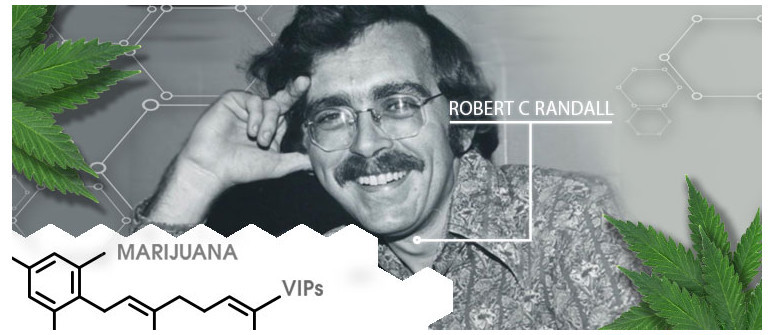Marijuana VIP: Robert C. Randall

Robert C Randall was the first patient to receive legal medical marijuana. His efforts to secure access and that of others to medical marijuana formed the contemporary framework for the modern legalisation movement.
During the 1970s, the United States government had effectively demonized cannabis all over the US, and convincing other world governments to do the same, cannabis was under lock and key.
Government grants for any research were only given to those wanting to prove the harm in cannabis and when the research unveiled that cannabis actually had beneficial uses, the studies were shut down. It was a dark time.
But then there was a lone United States man facing down the Gorgon of prohibition and its lackeys.
His name was Robert. C. Randall and in 1976 he was convincing the US government to recognize cannabis as having medicinal uses.
A MOVEMENT CONCEIVED IN A MOMENT
When he first tried weed, Robert Randall was a college student. When he received his degree and moved to Washington D.C for his career, his days of smoking pot seemed to be over.
Twelve months later he was diagnosed with advanced glaucoma. Any aspirations he had evaporated, and he ended up out of work and on welfare. It wasn’t long before the typical effects started to set in. He could feel the building pressure in his eyes. He could be blind by 30.
Not long after his diagnosis. Robert was sitting around with a few friends. One offered him a joint. It had been a long time since Randall had gotten high and he took the opportunity to relax and forget his woes.
Later, as he was enjoying being high, he glanced outside to notice the usual telltale halos around street lights—a symptom of glaucoma—had disappeared. This, he explained over two decades later, was the proverbial “eureka” moment.
“It was a singular moment. I immediately drew the connection between the use of marijuana and the now-absent haloes. Indeed, parts of my brain absorbed the connection so quickly and so assuredly that I was certain I must be stoned, which of course I was. I tried to follow the exploding synaptic spasm but was quickly left behind.”
Eventually, his realizations were accepted as personal fact. Marijuana was alleviating his symptoms. His intraocular pressure returned to the safe range.
His doctor was perplexed, but Robert did not mention the self-prescribed marijuana therapy. He told very few people, simply wanting to get on with his life and enjoy his saved vision. One person he did tell was his future wife, Alice O’Leary.
THE BEGINNING OF THE MEDICAL MARIJUANA MOVEMENT
After eighteen months of managing Roberts glaucoma with marijuana. They were busted for growing cannabis on their sun deck. Convinced that marijuana was helping Robert, they didn’t want to plead guilty, pay a fine and walk away with a misdemeanor. Serendipity played its part.
They discovered that the US federal government was engaged in research that showed marijuana was beneficial as a treatment for glaucoma. Robert contacted the researcher, and after a ten-day study, it was demonstrated that Robert would go blind without marijuana treatment.
In November 1976, Robert was declared not guilty of marijuana cultivation by reason of medical necessity. The federal government then granted his petition to gain access to federal supplies of marijuana. At the time Robert was the only person in the whole country allowed to legally possess medical cannabis. It dominated the news and launched the medical marijuana movement.
The couple soon heard from many other people who had discovered the therapeutic benefits of cannabis. In April 1977, 13 patients filed a petition with the US Attorney General's office to have cannabis rescheduled. The petition was unsuccessful, but many lessons were learned about the passion for the cannabis issue.
THE FATHER OF THE MEDICAL MARIJUANA MOVEMENT
From 1978 to 1981 The couple worked with patients across the country. 34 states amended existing laws. They founded the Alliance for Marijuana Therapeutics and tried to establish statewide research programs. They also lobbied for federal legislation they drafted which at one point had 110 sponsors.
Medical marijuana activism was difficult. The Alliance was the lead party during rescheduling hearings before the Administrative Law Judge of the DEA. In an early coup, the Judge recommended rescheduling medical cannabis. Unfortunately, the decision was overturned in the Appeals Court.
Next, they founded MARS-the Marijuana AIDS Research Service. This allowed hundred of AIDS patients to file requests for access to medical marijuana. As an indication of how hard line the government could be, they shut down the only legal access program in the country. The public outrage over this callous act directly led to the success of Prop 215 in California.
Robert Randall personally directed all of this activity for more than 20 years. Even when he had his free speech threatened, and his supply of legal medical marijuana disrupted a number of times.
Robert Randall reintroduced medical marijuana into the public consciousness. A degree in rhetoric made him a skilled and convincing orator and debater. Up until his death in 2001, he was fiercely dedicated to the rights of patients to use medical cannabis.
After 40 years, great strides have been made in the acceptance of cannabis as a medicine. Robert Randall, the father of the medical marijuana movement, would be truly amazed. May he rest in peace.


